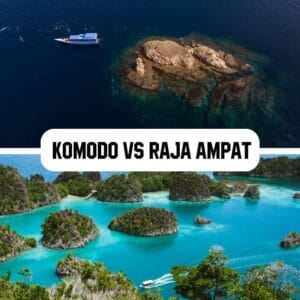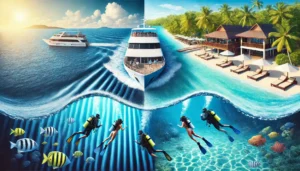
Best Liveaboards in Indonesia: Your Complete Guide to an Epic Diving Liveaboard Adventure
With over 17,000 islands, Indonesia lies at the heart of the Coral Triangle — offering some of the world’s richest marine biodiversity, from vibrant coral reefs and rare pelagic species to macro critters found nowhere else. While land-based resorts are excellent, embarking on a diving liveaboard opens up an entirely new dimension of exploration.
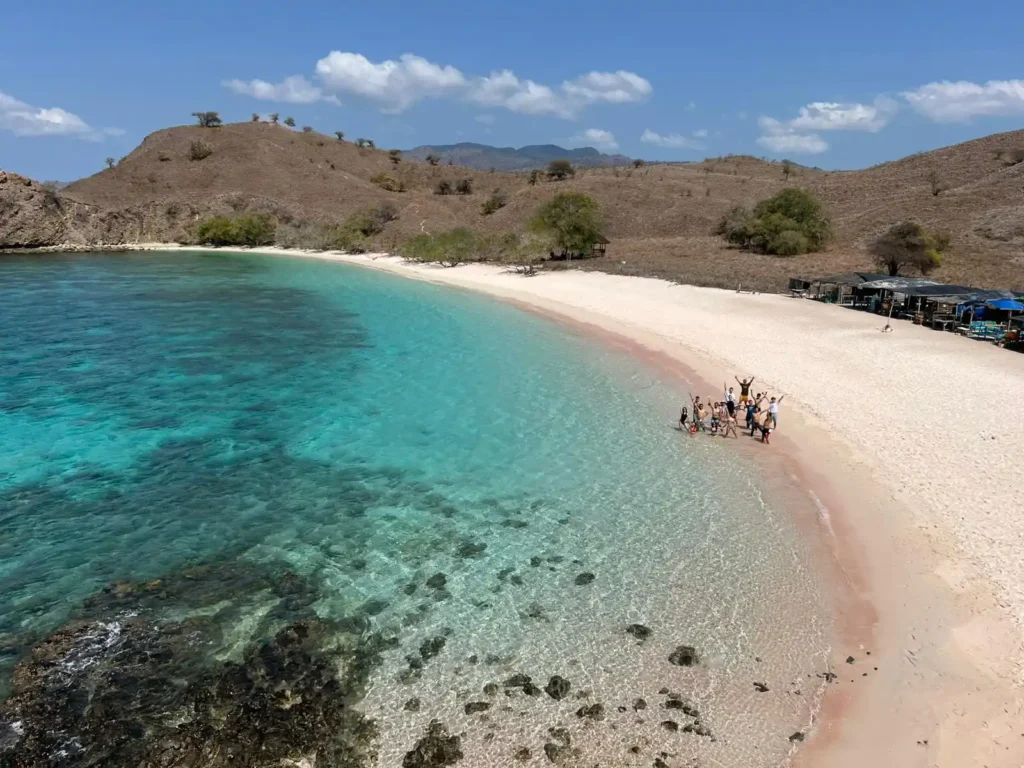
Imagine waking each day to dive from your boat, metres from the coral gardens or pelagic-rich channels, without daily transfers, packing and unpacking. In this friendly yet detailed guide, we’ll show you the best liveaboards in Indonesia, focusing on top regions like Komodo, Alor and Raja Ampat, and discuss features, best times, marine life and how to book with us at Shenron Liveaboard for an exceptional experience.
Why Choose a Diving Liveaboard in Indonesia?
- Access remote dive sites: Many of Indonesia’s hidden-gem sites lie far from shores — liveaboards bring you there.
- More dives, more adventure: Expect up to four dives a day (often including a night dive) without the constraints of daily boat trips.
- Immersive community vibe: Stay with like-minded divers, share stories, enjoy camaraderie onboard.
- All-in-one convenience: Accommodation, meals, tanks, weights and guided dives often included – less logistic hassle.
Above all, Indonesia’s diversity means every dive is an adventure — mantas soaring, shark patrolling blue water, intricate macro hidden among coral gardens.
Top Indonesian Liveaboard Regions
Komodo National Park
Location: Between the islands of Sumbawa and Flores.
Highlights: manta rays, strong currents, drift dives, the famous land-dwelling Komodo Dragon.
The underwater landscapes here are shaped by powerful currents and the confluence of Indian and Pacific Oceans. Expect reef sharks, large pelagics, vibrant soft corals and remote bays like Pink Beach. Liveaboards covering Komodo deliver a mix of adrenaline and beauty.
Alor Archipelago
Location: East Nusa Tenggara.
Highlights: less crowded, pristine coral gardens, strong macro focus, exceptional visibility.
Often called Indonesia’s best-kept diving secret, Alor combines easy conditions for macro lovers with opportunities for big fish and rare species like pygmy seahorses or rhinopias.
Raja Ampat
Location: West Papua.
Highlights: The world’s top marine biodiversity site — over 1,300 fish species, 75% of known coral species, thousands of islands.
From wall dives and drift channels to hidden muck sites and huge schools of fish, Raja Ampat is a diver’s dream. A liveaboard here means exploring remote lagoons, hidden pinnacles and sheer reefs.

Best Liveaboards in Indonesia: Key Highlights
Here are some standout liveaboards covering Komodo, Alor and Raja Ampat — each offering distinct itineraries, styles and luxury levels:
Shenron Liveaboard
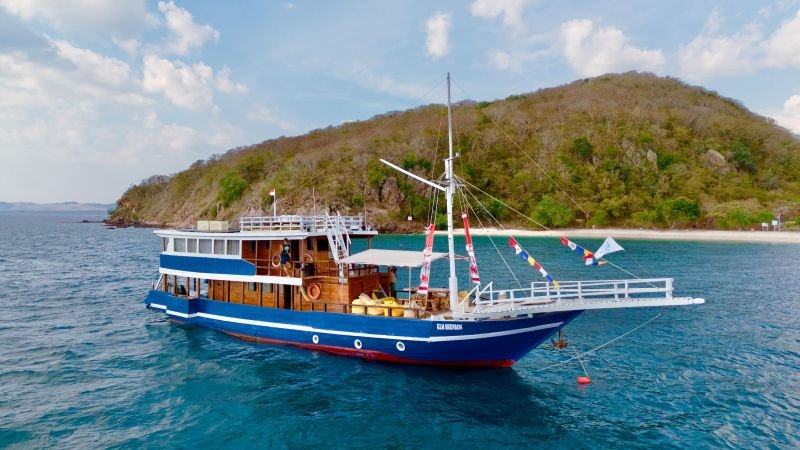
Regions: Komodo & Alor.
Key features: Only four cabins for an ultra-intimate feel; Nitrox onboard; expert guides; comfort without a huge price tag.
Why choose it: Perfect balance of premium service and value — ideal when you want boutique style with big diving.
Samambaia Liveaboard
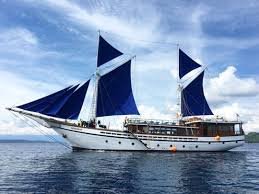
Regions: Komodo, Alor, Raja Ampat.
Key features: Smaller group sizes, camera room, bespoke routes to lesser-known sites.
Why choose it: For divers who want remote, little-visited reefs and a personalised experience.
MV Ambai
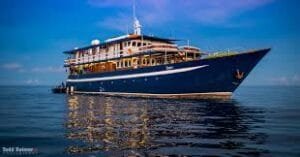
Regions: Raja Ampat, Komodo, Banda Sea.
Key features: Large dive deck, camera-friendly, flexible itineraries (7-12 nights).
Why choose it: Good mix of comfort and serious diving for both advanced and new liveaboard divers.
Choosing the Right Liveaboard
With so many options, how do you pick? Here are the key factors:
- Budget & Pricing: Some vessels start around USD 200/night; luxury yachts can exceed USD 500/night. Check what’s included (meals, dives, nitrox, park fees).
- Amenities & Comfort: From air-conditioned cabins and hot showers to modest bunk-beds and communal bathrooms — choose what matches your comfort level.
- Itinerary & Region: Ensure the liveaboard visits your preferred region (Komodo, Alor, Raja Ampat) and check the trip length (3-14 nights).
- Seasonal Planning: Liveaboards often move regionally: e.g., Komodo in dry season April-Nov, Raja Ampat Oct-Apr. Match your timing with region’s peak.
- Experience & Currents: If you’re new to liveaboards or diving in strong currents, look for more relaxed itineraries or shorter trips.
Best Times to Visit
While Indonesia offers year-round diving, each region has a peak season:
- Komodo: April-November (dry season); manta season often Dec-Mar.
- Alor: May-Oct calmer seas; Nov-Apr more rain but still diveable.
- Raja Ampat: Oct-Apr best visibility; May-Sept rainy but fewer boats and quiet dive sites.
Marine Life to Expect
This is what makes Indonesia shine:
- Manta rays: Cleaning stations in Komodo & Raja Ampat.
- Sharks: White-tip, black-tip reef sharks; wobbegongs and walking (epaulette) sharks in Raja Ampat; hammerheads in some Alor dives.
- Rare critters: Rhinopias, pygmy seahorses, vibrant nudibranchs.
- Schooling fish: Barracuda clouds, trevally, fusiliers, bumphead parrotfish.
- Coral & reef systems: Vast hard and soft coral gardens, sea fans, sponges – backdrop to all the action.
Preparing for Your Liveaboard Adventure
Diving Certification & Experience
Check vessel requirements: many liveaboards expect at least Advanced certification or some drift/blue-water experience (Komodo & Raja Ampat). Always bring your logbook and certificate.
Gear
While rental gear is included on many boats, bringing your own ensures comfort and familiarity. Consider:
– A 5mm wetsuit for cooler currents (Alor) or 3mm for warmer seas.
– Your dive computer and accessories.
– Personal macro kit if you’re into critters.
Insurance
Dive insurance is essential — make sure it covers remote locations and evacuation. Many liveaboards require proof of coverage.
Packing Essentials
- Reef-safe sunscreen – protect yourself and the reefs.
- Motion sickness remedies – some sea days may be bumpy.
- Camera gear, memory cards, spares.
- Certification card and logbook.
- Reusable water bottle, lightweight waterproof bag, ear plugs.
Conclusion
Choosing one of the best liveaboards in Indonesia unlocks a diving adventure like no other – from the manta-rich waters of Komodo and the hidden macro gems of Alor to the biodiversity explosion of Raja Ampat. Whether you’re a photographer chasing rare critters or an experienced diver craving big pelagics, there’s an Indonesian liveaboard for you.
When planning, focus on budget, comfort level, itinerary length, region and season. And above all: choose a boat and operator you trust. With Dragon Dive Komodo and our trusted partners, your liveaboard experience awaits — seamless, spectacular and unforgettable.
🐉 Ready to dive deeper? Contact Dragon Dive Komodo to find your ideal liveaboard itinerary, check availability, and get personalised advice. Your adventure in Indonesia’s epic underwater frontier starts here!




